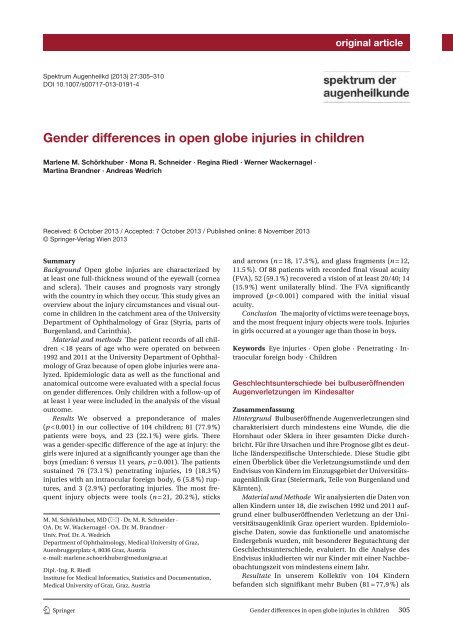spektrum der augenheilkunde - 150 Jahre Augenklinik Graz
spektrum der augenheilkunde - 150 Jahre Augenklinik Graz
spektrum der augenheilkunde - 150 Jahre Augenklinik Graz
Sie wollen auch ein ePaper? Erhöhen Sie die Reichweite Ihrer Titel.
YUMPU macht aus Druck-PDFs automatisch weboptimierte ePaper, die Google liebt.
original articleSpektrum Augenheilkd (2013) 27:305–310DOI 10.1007/s00717-013-0191-4Gen<strong>der</strong> differences in open globe injuries in childrenMarlene M. Schörkhuber · Mona R. Schnei<strong>der</strong> · Regina Riedl · Werner Wackernagel ·Martina Brandner · Andreas WedrichReceived: 6 October 2013 / Accepted: 7 October 2013 / Published online: 8 November 2013© Springer-Verlag Wien 2013SummaryBackground Open globe injuries are characterized byat least one full-thickness wound of the eyewall (corneaand sclera). Their causes and prognosis vary stronglywith the country in which they occur. This study gives anoverview about the injury circumstances and visual outcomein children in the catchment area of the UniversityDepartment of Ophthalmology of <strong>Graz</strong> (Styria, parts ofBurgenland, and Carinthia).Material and methods Th e patient records of all children< 18 years of age who were operated on between1992 and 2011 at the University Department of Ophthalmologyof <strong>Graz</strong> because of open globe injuries were analyzed.Epidemiologic data as well as the functional andanatomical outcome were evaluated with a special focuson gen<strong>der</strong> differences. Only children with a follow-up ofat least 1 year were included in the analysis of the visualoutcome.Results We observed a prepon<strong>der</strong>ance of males( p < 0.001) in our collective of 104 children; 81 (77.9 %)patients were boys, and 23 (22.1 %) were girls. Therewas a gen<strong>der</strong>-specific difference of the age at injury: thegirls were injured at a significantly younger age than theboys (median: 6 versus 11 years, p = 0.001). The patientssustained 76 (73.1 %) penetrating injuries, 19 (18.3 %)injuries with an intraocular foreign body, 6 (5.8 %) ruptures,and 3 (2.9 %) perforating injuries. The most frequentinjury objects were tools ( n = 21, 20.2 %), sticksM. M. Schörkhuber , MD ( ) · Dr. M. R. Schnei<strong>der</strong> ·OA. Dr. W. Wackernagel · OA. Dr. M. Brandner ·Univ. Prof. Dr. A. WedrichDepartment of Ophthalmology, Medical University of <strong>Graz</strong> ,Auenbruggerplatz 4 , 8036 <strong>Graz</strong> , Austriae-mail: marlene.schoerkhuber@medunigraz.atDipl.-Ing. R. RiedlInstitute for Medical Informatics, Statistics and Documentation,Medical University of <strong>Graz</strong> , <strong>Graz</strong> , Austriaand arrows ( n = 18, 17.3 %), and glass fragments ( n = 12,11.5 %). Of 88 patients with recorded final visual acuity(FVA), 52 (59.1 %) recovered a vision of at least 20/40; 14(15.9 %) went unilaterally blind. The FVA significantlyimproved ( p < 0.001) compared with the initial visualacuity.Conclusion Th e majority of victims were teenage boys,and the most frequent injury objects were tools. Injuriesin girls occurred at a younger age than those in boys.Keywords Eye injuries · Open globe · Penetrating · Intraocularforeign body · ChildrenGeschlechtsunterschiede bei bulbuseröffnendenAugenverletzungen im KindesalterZusammenfassungHintergrund Bulbuseröffnende Augenverletzungen sindcharakterisiert durch mindestens eine Wunde, die dieHornhaut o<strong>der</strong> Sklera in ihrer gesamten Dicke durchbricht.Für ihre Ursachen und ihre Prognose gibt es deutlichelän<strong>der</strong>spezifische Unterschiede. Diese Studie gibteinen Überblick über die Verletzungsumstände und denEndvisus von Kin<strong>der</strong>n im Einzugsgebiet <strong>der</strong> Universitätsaugenklinik<strong>Graz</strong> (Steiermark, Teile von Burgenland undKärnten).Material und Methode Wir analysierten die Daten vonallen Kin<strong>der</strong>n unter 18, die zwischen 1992 und 2011 aufgrundeiner bulbuseröffnenden Verletzung an <strong>der</strong> Universitätsaugenklinik<strong>Graz</strong> operiert wurden. EpidemiologischeDaten, sowie das funktionelle und anatomischeEn<strong>der</strong>gebnis wurden, mit beson<strong>der</strong>er Begutachtung <strong>der</strong>Geschlechtsunterschiede, evaluiert. In die Analyse desEndvisus inkludierten wir nur Kin<strong>der</strong> mit einer Nachbeobachtungszeitvon mindestens einem Jahr.Resultate In unserem Kollektiv von 104 Kin<strong>der</strong>nbefanden sich signifikant mehr Buben (81 = 77,9 %) als1 3Gen<strong>der</strong> differences in open globe injuries in children 305


